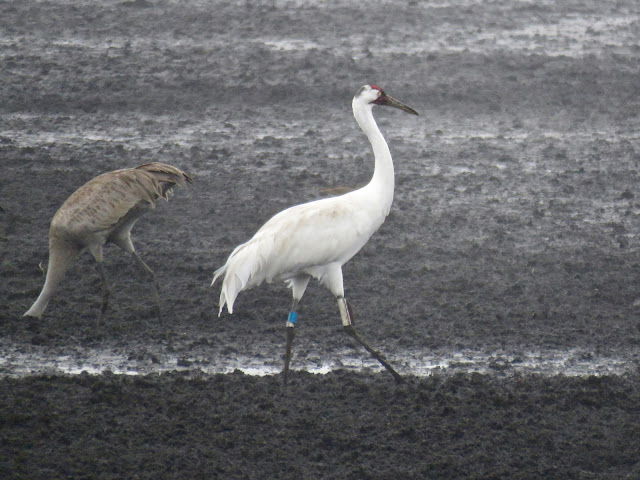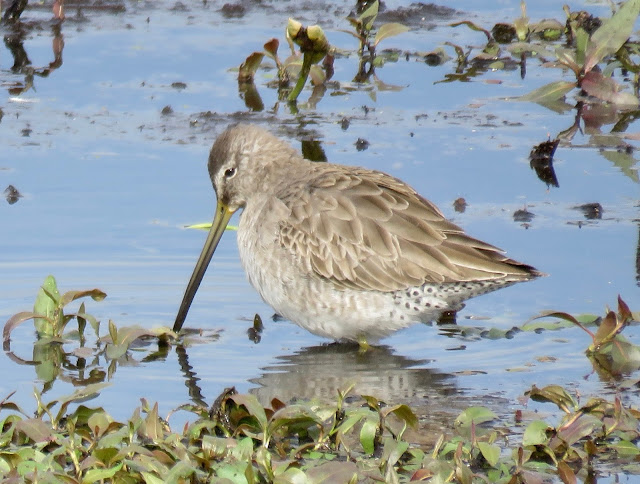Birding during the first half of January had been pretty spectacular. Vermilion Flycatcher, Dickcissel, and Red-cockaded Woodpecker were the headliners of a very busy opening of the year. What could happen during the second half of the month to top that? Glad you asked ...
I led a field trip for Alachua Audubon to Circle B Bar Reserve in Lakeland on January 14. It may seem like a long drive for a Saturday morning birding trip, but it's well worth the effort. Circle B is ALWAYS birdy. We spent some time birding the parking lot area, dipping (by a few minutes) on the Myna that had been seen there but scoring with a Prairie Warbler. Then just a few steps away from the parking lot we encountered the Painted Bunting in the photo above. What a gaudy sight!
When we finally reached the wetlands area, we quickly added a nice variety of waders and raptors. I love Snowy Egrets like the one above, but always have a hard time photographing them. I have trouble with the brilliant white of their plumage, so I was happy to get this shot. Don't you love the bright yellow feet? Also in the area were Black-bellied Whistling Ducks, Limpkins, and Blue-winged Teal. While I stood there admiring all of these fabulous birds, I noticed a huge kettle of vultures soaring high above us. I gave them a cursory look and noticed one that was different than the rest. At that point one of my group asked me a question, and I got distracted. Later I learned that the unusual bird up there was a Short-tailed Hawk. I'm pretty certain that was the bird I noticed, but I didn't ID it at the time.
Next we turned to the northwest along Marsh Rabbit Run. Almost immediately we encountered a little pool with this Pied-billed Grebe. Such a cute little bird! And just above him was ...
... a female Belted Kingfisher. This is one of the few bird species that defies the birding rule of thumb that the male is prettier than the female. That extra reddish breast band is very becoming!
Banana Creek Canal runs along the south side of this trail, and it's one of the most reliable places I know to get close looks at Green Herons. I especially like this bird's color palette with its deep red and green on the flanks and back, the stark white setting off the breast streaks, and the gold edging to the feathers of its wings. Fortunately, this beauty was way too busy hunting to mind my presence just a few feet away. I think the green stuff clinging to its legs is duckweed.
The open water at the end of Marsh Rabbit Run is usually good for a few nice surprises. Several Royal Terns (above) were joined by a couple of Forster's Terns in a mad dash back and forth over the water in search of tasty treats. The Royal in the photo above stopped for a few minutes' rest, affording the half dozen photographers nearby a chance to snap away at their leisure. Then the bird took flight again in the eternal quest for food. Also in the area were a few Roseate Spoonbills, always a treat, and two Peregrine Falcons, always a thrill!
The day ended with a quick hike over to the lake to check out a couple of Brown Pelicans, and then this Barred Owl, just off the parking lot. For the day the group tallied about 65 species.
A few days later Linda Holt was traveling along a road near Newberry in Alachua County when she noticed a Scissor-tailed Flycatcher on a nearby wire. This bird is more typically found in Texas than in Florida. The word spread pretty quickly, and I made the dash out there to add a special bird to my year list. The photo isn't the best - the distance was too great and my camera doesn't have any special lens, but what the heck -- it's a Scissor-tailed Flycatcher!
I have mentioned in a previous blog that once a month I lead a field trip for a group of birders who have retired from the world of work. We start the morning by birding somewhere and end it by having lunch together at a local restaurant. On January 19 we walked out La Chua Trail on Paynes Prairie. Our first stop was the boardwalk in the hopes of relocating the sparrows and Dickcissel that have been hanging out in the area. Early on, we had only limited success. Song and Savannah Sparrows were most numerous, a few people got a quick look at a Lincoln's Sparrow, and one particularly cooperative Vesper Sparrow (below) stopped to watch us watch him.
The day was pretty overcast and bleak, and we started out in a heavy fog, so most photography wasn't very successful, at least not for me. So one of the few shots worth publishing is this one of the Florida state bird, the Northern Mockingbird (below).
Overall, the day was mildly successful. We saw Green-winged and Blue-winged Teals, Northern Shovelers, Black-bellied Whistling-Ducks, Wilson's Snipes, a few Long-billed Dowitchers, a lone Stilt Sandpiper, and thousands of Sandhill Cranes. But we got really lucky at the end of the trail when close by the viewing platform we saw ...
... a Whooping Crane that dwarfed a nearby Sandhill Crane. I had been out to the platform looking for him a few times and was rewarded with only unsatisfying distant glimpses through a scope. This time he strutted right by us looking majestic and proud. I've read various estimates that there are between 400 and 500 of these birds left in the world, so seeing one is an enormous treat. I hope that some day, people won't understand the fuss because there will be so many of them around. But for now, this is one of the rarest birds in the world, and worth a long, loving gaze.
On January 23 I drove over to Gainesville's Depot Park. Andy Kratter had spotted a Common Goldeneye in the large pond near the park's entrance. This is a locally uncommon bird, so I wanted to add it to my year list. I found the bird among a few Ring-necked Ducks, but I had to wait about 30 minutes under a cloudy sky before it swam in close enough for me to get a photo.
That same afternoon, the sun broke through, the temperature climbed, and my feeders got really busy. I was especially pleased to see this Eastern Bluebird (below) that stopped by to snack on some mealworms.
On the fourth Wednesday of every month from September through May I get to lead a bird walk at Sweetwater Wetlands Park in Gainesville. This relatively new facility has only been open to the public for about a year and half, but it already has become a premier birding hotspot in the area. The January walk started out in another heavy fog, but who cares? Sweetwater is always a wonderful place, and this time I was joined by several people who were both new to the park and new to birding. This gave me the chance to stop and appreciate even our most common birds because I could see them through beginners eyes again. How cool is it to compare male and female Red-winged Blackbirds for the first time? It's even cooler to point out the comparison to new and eager birders. A couple of hours of birding yielded about 35 species, ending with over 400 Black-bellied Whistling-Ducks (below) standing together in the southwest corner of the park.
The month was winding to a close, but it still held some nice birding opportunities. The morning after the Sweetwater trip a couple of friends and I walked east on the Hawthorne Trail and took the cutoff to the Alachua Lake Overlook. This is one of the prettiest walks in Gainesville, especially when the wildflowers and plum trees are in bloom. Along the way, we encountered this Orange-crowned Warbler:
Two days later I was back at La Chua Trail for another Audubon field trip. This time I was lucky enough to get a good look at this Long-billed Dowitcher:
The last day in January held one more neat surprise for me. I was in my own driveway, looking for something I had left in my van, when I heard quite a ruckus behind me. It was the unmistakable war cry of a Red-shouldered Hawk. Make that two Red-shouldered Hawks, sitting together atop the light pole directly across the street. How cool is that??
And so ended a fantastic month of birding. During January I saw 109 species of birds within Alachua County's borders and another 30 outside of the county for a total of 139 species. I hope February is as successful.

















No comments:
Post a Comment
Tell me what you think!